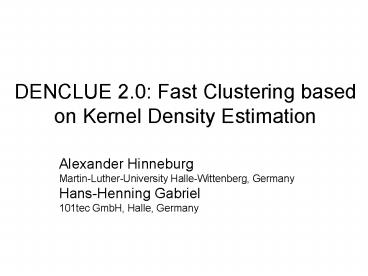DENCLUE 2'0: Fast Clustering based on Kernel Density Estimation - PowerPoint PPT Presentation
1 / 18
Title:
DENCLUE 2'0: Fast Clustering based on Kernel Density Estimation
Description:
DENCLUE 2.0: Fast Clustering based on Kernel Density Estimation. Alexander Hinneburg. Martin-Luther-University Halle-Wittenberg, Germany. Hans-Henning Gabriel ... – PowerPoint PPT presentation
Number of Views:881
Avg rating:3.0/5.0
Title: DENCLUE 2'0: Fast Clustering based on Kernel Density Estimation
1
DENCLUE 2.0 Fast Clustering based on Kernel
Density Estimation
- Alexander Hinneburg
- Martin-Luther-University Halle-Wittenberg,
Germany - Hans-Henning Gabriel
- 101tec GmbH, Halle, Germany
2
Overview
- Density-based clustering and DENCLUE 1.0
- Hill climbing as EM-algorithm
- Identification of local maxima
- Applications of general EM-acceleration
- Experiments
3
Density-Based Clustering
- Assumption
- clusters are regions of high density in the data
space , - How to estimate density?
- parametric models
- mixture models
- non-parametric models
- histogram
- kernel density estimation
4
Kernel Density Estimation
- Idea
- influence of a data point is modeled by a kernel
- density is the normalized sum of all kernels
- smoothing parameter h
Gaussian Kernel
Density Estimate
5
DENCLUE 1.0 Framework
- Clusters are defined by local maxima of the
density estimate - find all maxima by hill climbing
- Problem
- const. step size
Gradient
Hill Climbing
const. step size
6
Problem of const. Step Size
- Not efficient
- many unnecessary small steps
- Not effective
- does not converge to a local maximumjust comes
close - Example
7
New Hill Climbing Approach
- General approach
- differentiate density estimate and set to zero
- no solution, but can be used for iteration
8
New DENCLUE 2.0 Hill Climbing
- Efficient
- automatically adjusted step size at no extra
costs - Effective
- converges to local maximum (proof follows)
- Example
9
Proof of Convergence
- Cast the problem of maximizing kernel denstiy
as maximizing the likelihood of a mixture
model
- Introduce hidden variable
10
Proof of Convergence
- Complete likelihood is maximized by EM-Algorithm
- this also maximizes the original likelihood,
which is the kernel density estimate - When starting the EM with we do the
hill climbing for
E-Step
M-Step
11
Identification of local Maxima
- EM-Algorithm iterates until
- reached end point
- sum of k last step sizes
- Assumption
- true local maximum is in a ball of around
- Points with end points
closerbelong to the same maximum M - In case of non-unique assignmentdo a few extra
EM iterations
12
Acceleration
- Sparse EM
- update only the p points with largest posterior
- saves 1-p of kernel computations after first
iteration - Data Reduction
- use only p of the data as representative points
- random sampling
- kMeans
13
Experiments
- Comparison of DENCLUE 1.0 (FS) vs. 2.0 (SSA)
- 16-dim. artificial data
- both methods are tuned to find the correct
clustering
14
Experiments
- Comparison of acceleration methods
15
Experiments
- Clustering quality (normalized mutual
information, NMI) vs. sample size (RS)
16
Experiments
- Cluster Quality (NMI) of DENCLUE 2.0 (SSA) and
acceleration methods and k-Means on real data
sample sizes 0.8, 0.4, 0.2
17
Conclusion
- New hill climbing for DENCLUE
- Automatic step size adjustment
- Convergence proof by reduction to EM
- Allows the application of general EM
accelerations - Future work
- automatic setting of smoothing parameter h(so
far tuned manually)
18
Thank you for your attention!































